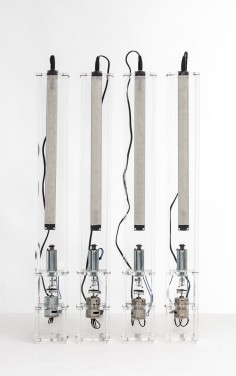Mo H. Zareei
Rasper

source: creativeapplicationsnet
Created by Mo H. Zareei, Rasper, Mutor and Rippler are three mechatronic sound-sculptures inspired by Brutalist architecture. The instruments are grouped into three different categories, based on the material and sound production mechanism they employ.
In aestheticizing the normally mundane sonic byproducts of urban industrial life, they employ non-musical objects such as DC motors and actuators, remove them from their everyday context – where they are tools to help run our machines and their noise is sheer sonic byproduct – and turn them into a medium for sonic expression. This contextual transmutation is accomplished through an apparatus combining mechatronic techniques and microcontroller programming that is used to control their noise on rigidly grid-based patterns, where loops, pulses, and metric rhythms form a strict platform through which noise is structured. As in the Brutalist buildings, these sculptures fully expose the materiality and bodily existence of their components in austerely geometric structures and repetitive modules. In order to boost the visceral and sensory experience, every single noise pulse is highlighted in synchronous bursts of fluorescent light, preserving the work’s confrontational, cold, and Brutalist aesthetics.
Rasper’s sound-generating mechanism is based on surface friction between a sharp piece of spring steel and a plastic disk rotated by a DC motor, while the contact between the two is made using a linear actuator. In Rippler, the actuation noise of the linear actuator is amplified and transduced using a thin sheet of steel, whereas in Mutor, the sonic output is the noise of a DC motor, modulated in terms of timbre and amplitude.
The instruments are driven using a custom-built driver board that has been designed as an Arduino Mega shield. The Arduino board itself is converted into a MIDI device using the HIDUINO protocol, and the communication is done using MIDI messages from software. The circuit was designed using Altium Designer. All instruments were designed in SolidWorks and the enclosures were laser-cut from sheets of clear acrylic.
.
.
.
.
.
.
.
source: blogatmel
Created by electronic musician Mo H. Zareei, Rasper, Mutor and Rippler are a mechatronic sound-sculpture trio inspired by Brutalist architecture — a form of design that had originated from the French word for “raw concrete” and experienced popularity throughout the 1950s to mid-1970s. For this project, the Maker grouped instruments by material and sound production mechanisms into three categories.
“As in the Brutalist buildings, these sculptures fully expose the materiality and bodily existence of their components in austerely geometric structures and repetitive modules. In order to boost the visceral and sensory experience, every single noise pulse is highlighted in synchronous bursts of fluorescent light, preserving the work’s confrontational, cold, and Brutalist aesthetics,” the Maker tells Creative Applications.
First, Rasper is comprised of a DC motor, a push solenoid, a 3D-printed plastic disk and a piece of spring steel. These components are all held together in an open-faced frame made of clear acrylic. The sound-generating mechanism is based on the surface friction between a sharp piece of spring steel and a plastic disk rotated by a DC motor, while the contact between the two is made by a linear actuator.
For Rippler, the actuation noise of the linear actuator is amplified and transduced using a thin sheet of steel.
Whereas in Mutor, this sound-object entails a DC motor placed housed within a transparent acrylic box along with a push-type solenoid mounted on the edge of the enclosure’s pivoting side. Through mechatronics and microcontroller programming, the DC motor is manipulated in terms of timbre, amplitude and frequency to produce varying tunes.
All of the instruments are controlled by a custom PCB, which has been designed as an Arduino Mega shield. The Arduino (ATmega2560) itself is converted into a MIDI device using HIDUINO firmware, while communication is done through MIDI messages. Each piece of the ensemble are also equipped with a strip of bright LEDs that pulse with the music to enhance the audiovisual experience.
.
.
.
.
.
.
.
source: luxorgnz
Rasping Music is an audiovisual installation in appreciation of the ignored aural/visual phenomena surrounding our daily lives. It involves new mechatronic instruments that employ some everyday objects of the urban life, shifting the medium in which they normally exist, and formalizing them through patterns of a rhythmic grid. In these instruments, DC motors and actuators are detached from the realm in which they are tools to help run our machines––where their noise is merely the aural artifact of the urban technology––, and turned into amedium for sound/music. In contrast to their everyday location, i.e., hidden inside black boxes of our machines, their bodily existence is fully exposed, flaunting the physicality of their noise. This physicality is further highlighted in arrays of white light, which––unlike the florescent lights of our offices––are not there to help us see things, but to be seen themselves.
Mo H. Zareei aka mHz is an electronic musician, sound artist, and a music technology researcher, born and raised in Iran. After completing his Physics degree at Shahid Beheshti University of Tehran, Zareei moved to the United States in 2010 to study at California Institute of the Arts, where he started to explore the world of electronic music, making sound from scratch with codes, algorithms, and circuits. Using custom-built software and hardware, his experiments with sound cover a wide range from electroacoustic and electronic compositions to mechatronic sound-sculptures and installations. Striving to turn the harsh, unwanted, and unnoticeable into the pleasing and accessible, Zareei’s work is particularly targeted at the point where noise meets grid-based structures. He is currently living in New Zealand, where he is pursuing his PhD research on noise music and mechatronics at Victoria University of Wellington.

